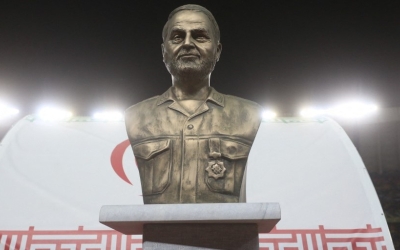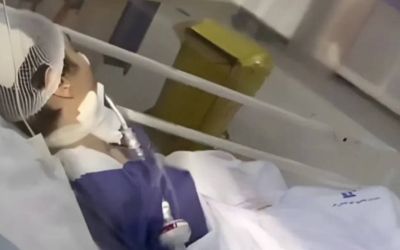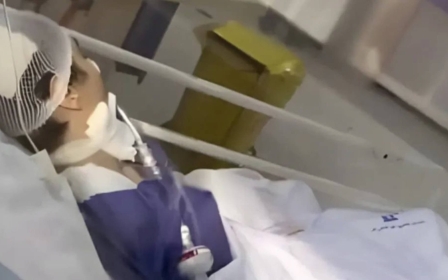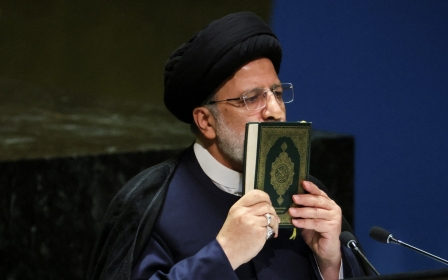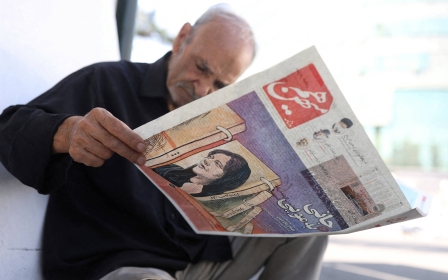Iranian press review: Protesting steel workers handed 74 lashes

Floggings ordered for workers after protest
According to Bahar News, 17 workers at the Iran National Steel Industrial Group in the southwestern city of Ahwaz have been sentenced to 74 lashes each after they held a protest against mismanagement and overdue salaries.
The workers, whose names were not revealed, were found guilty by the local branch of the Islamic Revolutionary Court of "disturbing public order by causing fanfare and tumult".
The convicted were initially also sentenced to three-month prison terms, which were replaced by fines of 25m Iranian rials (about $50.5 on the open market).
Since 2018, workers at the semi-government firm have organised several strikes and sit-ins demanding unpaid wages and year-end bonuses, as well as better working conditions.
New MEE newsletter: Jerusalem Dispatch
Sign up to get the latest insights and analysis on Israel-Palestine, alongside Turkey Unpacked and other MEE newsletters
In recent years, the authorities' response to labour activists' demands has often been harsh, with many of them sentenced to prison terms. Flogging has also been widely used by Iran's judicial system to punish dissidents and labour activists.
In November 2020, Davoud Rafiei, a sacked worker at the Pars Khodor automobile firm, received 74 lashes for "insulting the labour minister".
Ruhollah Barzin and Rasoul Taleb Moghadam were other workers who were flogged that year.
Barzin, a bakery worker, received 55 lashes for publishing comments critical of the government on social media, and Taleb Moghadam was flogged 74 times and then imprisoned for two years for organising workers' protests.
Tehran plastered with Soleimani's image
A bust of Qassem Soleimani made headlines around the world earlier this week when it prompted a Saudi football team to abandon a match in the Iranian city of Isfahan. Since then, Tehran has been flooded with more images of the late Revolutionary Guard general.
On Tuesday, Tehran's municipality, under the management of the ultra-conservative mayor Alireza Zakani, installed several banners on the city’s streets with Soleimani’s image.
Fars news agency, which is affiliated with the Revolutionary Guard, published images of the banners emblazoned with the words “They are afraid of his eyes” in Persian.
Fars suggested that the move was in response to the cancelled match on Monday between Saudi Arabia’s al-Ittihad and Iran’s Sepahan in Isfahan.
"A few hours after Saudi Arabia's al-Ittihad football team abstained from playing against Isfahan's Sepahan on the pretext of having a statue of Haj Qassem Soleimani in the stadium, Tehran's municipality decorated the streets of Tehran with the image of Iran's national hero," the agency reported.
Soleimani was the commander of the Republican Guard’s powerful Quds Force, responsible for extraterritorial operations. He was assassinated in a US drone attack near Baghdad airport in 2020.
The Isfahan row marked the second instance that Soleimani’s image has caused issues for Tehran since the restoration of ties between Iran and Saudi Arabia in March.
When Saudi Foreign Minister Faisal bin Farhan Al Saud visited Iran in June after seven years of estrangement, he demanded that a joint news conference with his Saudi counterpart be moved to a different location at short notice.
At that time, local media reported that the last-minute relocation was due to the presence of an image of Soleimani displayed on the wall.
‘At least 123’ killed in southeastern protests
A new report by human rights activists has unveiled fresh details of security forces’ deadly crackdown on demonstrators in the southeastern cities of Zahedan and Khash.
This new report was published on the anniversary of the deadly protests in the provincial capital of Sistan, Zahedan, known in Iran as "Zahedan’s Bloody Friday".
On 30 September last year, following Friday prayers at Zahedan’s Makki mosque, security forces and police opened fire on protestors, resulting in the deaths of scores of people.
On the anniversary of the incident, the Haalvsh website published the names of 105 people it said were killed during the protests or died from injuries in the following days, including one person who died under torture after being arrested.
The report highlighted that at least 16 of the slain protestors were under 18.
Haalvsh also documented the names of 11 people who were killed on 4 November in the city of Khash. The total death toll on that day was 18, including two children.
Last year's anti-establishment demonstrations in Zahedan began later than those in Tehran and other major cities, which were sparked by the death in custody of Mahsa Amini, a young woman arrested for “incorrectly” wearing her hijab.
Zahedan is the only city where residents have continued protests every week after Friday prayers since last year's events.
*Iranian press review is a digest of news reports not independently verified as accurate by Middle East Eye.
Middle East Eye delivers independent and unrivalled coverage and analysis of the Middle East, North Africa and beyond. To learn more about republishing this content and the associated fees, please fill out this form. More about MEE can be found here.


